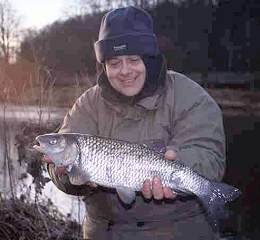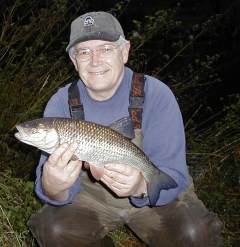There’s one thing that we are all guaranteed – it is that the seasons will come and go!
In these isles of ours we are blessed(?) with all extremities of weather, perhaps not to the degree of some areas but enough for us to have to be adaptable if we want to get the most out of the fishing year. In this article I would like to chat about fishing and keeping warm in the winter months.
As well as having fished for many a cold year I have also spent time inplaces such as the Brecon Beacons during the winter. I do not mention thatto instil any suggestion of toughness but I think in an article of this ilkreaders should be able to trust that the writer knows at least a little ofwhat he is talking about.
In fishing we are not talking of a survival situation, or at least weshouldn’t be! But if we want to fish efficiently it is important that wekeep as comfortable as possible.
|
|
| |
In order to stay comfortable we need to firstly think about our bodies. By that I mean areas of heat loss; extremities like feet and hands will spoil our day’s fishing if they get too cold and whilst most people know that a lot of body heat is lost through the head, every winter I see anglers without head gear. The depth of winter is no time for those trendy baseball caps! Put them away and start to look at warmer gear. My own favourite is still a woolly hat that I can pull down over my ears if need be. Anotheruseful style is the deerstalker type that again has protection for the ears, and the added bonus with those is that they offer more wind protection if you don’t like wearing hoods. Another useful bit of kit for the upper regions is a neck tube that can be purchased from outdoor-type shops. They really do help to stop heat loss from the neck area.
|
|
| |
Moving down to the hands, this is, in my opinion, still the trickiestarea to keep warm. If you are, say, pike fishing, then it’s not too much of aproblem. Gloves can be worn and then removed to do the business. If, however,you are trotting flake it ain’t so simple!
I can put up with a lot as far as my hands are concerned but if the cold is getting the better of me my own preference is for a pair of neoprene mitts that I can slip my fingers in and out of quickly. A point well worth remembering whilst in this region is towear snug-fitting cuffs, a wind blowing up your arms will soon make you uncomfortable and miserable.The feet are an area where we are well looked after, we really have noneed to suffer cold feet any more! All we need to consider is how far we aregoing to walk during the day! If very little or no mobility is involved thenfor sheer warmth a pair of ‘moonboots’ takes some beating. If, however, youwant to be mobile then you may be better off looking at a pair of qualitywellington-type boots or walking boots coupled with quality socks. And ain’tthere some quality socks out there nowadays! We really are spoilt,waterproof breathable socks? We really have got it made!
A word of warning though – no socks will keep your feet warm if you then push them into tight-fitting boots. It is important that you can move your toes about freely onceyour boots are on. Putting three pairs of socks on can defeat the object.
|
|
| |
A thin, thermal sock, followed by a thicker oversock and a decent boot withroom to move, and your feet shouldn’t get too uncomfortable. If you preferwalking boots to wellingtons go for the best you can afford, preferably witha breathable waterproof lining. Walker’s gaiters can also be a boon withboots for walking long stretches of rivers and lakes. They keep outstones and the like and also offer protection from longish damp grass. As faras wellington type boots are concerned there are now some excellent ones onthe market, the type I wear have a neoprene lining and I can walkconsiderable distances in them. Again, buy the best you can afford, but shoparound and haggle!
I have left the major items of clothing until last because there ismuch to consider – degrees of cold and wet, wind chill and the type offishing all need to be taken into account.
|
|
| |
In a static situation a quality one-piece suit can be a good choice and comparable to a mobile sleeping bag! Some even need very little clothing underneath, and my own one-piece also serves as a floatation suit, and if you fish from a boat that type is well worth looking at for obvious reasons. One of my favourite types of winter fishing isroving on small to medium-size rivers, and in this situation a layered system ofclothing can prove more suitable. The layers are dictated, of course, by theconditions, but can be added to or removed to suit depending on the weatherand the amount of energy used.
I will describe my own preference. The first layer is optional, depending on what conditions I will be faced with, but consists of a two-piece top and long-johns. It is important that this first layer has breathable qualities and that it fits snugly, it’s job is to be a thermal layer and pass moisture (sweat!) to it’s surface away from the body where it is evaporated away with the help of the heat from the body.
The next layer is again optional, can be a light weight fleece-type suit or two-piece. This layer is not as snug as the first. The idea is to trap layers of air, and it is still important that the layer allows the passage of moisture.A good top layer can now be added and is down to personal choice.
|
|
| |
Biband brace trousers can be a boon to your back in the cold winter winds,and if possible go for a breathable. This again helps to get rid of theclamminess that can occur if body moisture cannot escape. A fleece can beworn as an upper body garment and can be opened or removed to regulate bodytemperature depending if you are on the move or static.Fleeces are now a bit of a fashion thing and seem to be worn by themselves to keep out the cold. They are designed to insulate but it is to be remembered that they will not protect the body from wind-chill, and believe me a cold wind will soon have you wanting to scurry home if you are not protected from it! The top layer of clothing needs to be on if the other layers are to work, a waterproof, windproof, breathable top garment is the final layer.
The beauty of the layer system is that they can be stored in a rucksackuntil needed and you choose the degree of protection that is ideal for activedays.
Buy the best gear you can afford, it will pay dividends in the end. If your budget is tight (like mine!) take a look at a decent army surplus store. There is some excellent surplus gear available from them, including breathable gear, and they are well worth a look.















